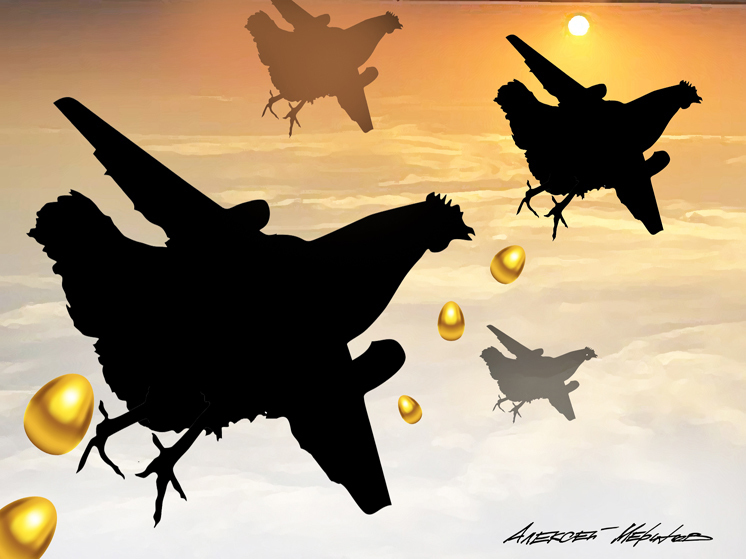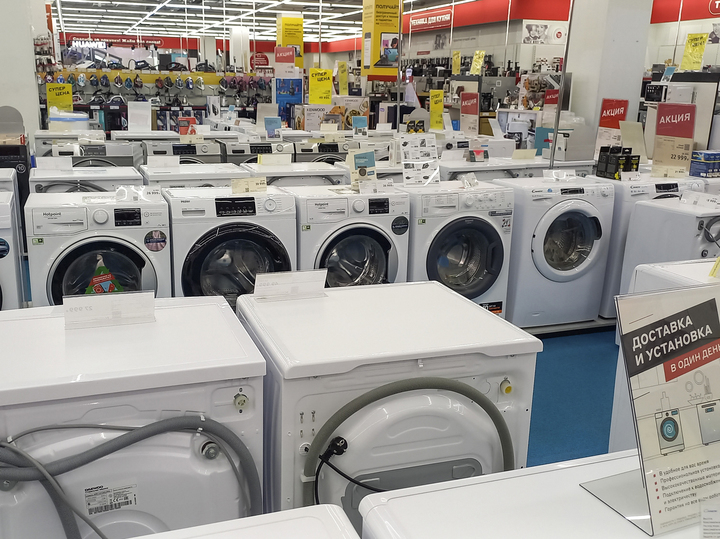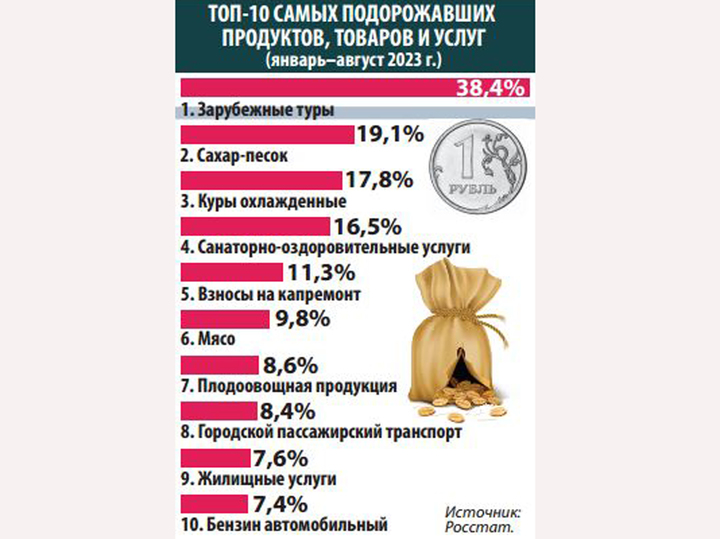From chicken to air tickets: the goods and services that will rise in price the most are named
Inflation in Russia accelerated in earnest this fall and has no intention of slowing down. The government predicts that the September figure of 5.7% will rise to 7.5% by December. Most often, such a rampant price is blamed on the sharply depreciated ruble towards the end of summer. However, for example, the vast majority of products are produced domestically, but despite this, according to Rosstat, the minimum “edible set” has risen in price by 8.9% since the beginning of the year. But this is not enough: according to experts, in the near future the cost of a number of products — meat, fish, sugar, vegetables, fruits and even baby food. High food inflation, rising energy prices and declining incomes are forcing Russians to look for increasingly more economical solutions. To help them with this and explain what is happening with prices on the shelves, MK invited experts: Director of the Institute of Socio-Economic Research of the Financial University under the Government of the Russian Federation Alexey Zubets and Chairman of the Board of the Confederation of Consumer Societies Dmitry Yanin.

— The rise in inflation in September is due to the collapse of the ruble. Let me explain with the example of bananas. Judging by the analysis of consumer prices carried out by Rosstat, bananas have risen in price by 30% since the beginning of the year. That is, exactly as much as the ruble collapsed. In terms of price growth rates, sometimes apples, tomatoes and a whole range of other goods that react very quickly to devaluation are sometimes close to bananas. Meanwhile, the devaluation was beneficial to the government. Officials do not hide their joy: the collapse of the ruble — This is a plus for the budget, for the income that comes from oil exports. The consequence of such a collapse of the ruble — rising prices. People will pay for the fall of the ruble by buying familiar goods at a higher cost. According to the Russians themselves, inflation in Russia at the end of the year will be 11%, which is 2.5 times higher than what the Ministry of Economic Development predicted. And this opinion of Russians looks much wiser than the forecast of officials.
— If we look at the official Rosstat data for July, the growth in consumer prices was 4.5%. That is, even in the summer inflation was insignificant. But if we take the rate of price growth over recent weeks, then indeed they are increasing quite noticeably. This is due, in particular, to the devaluation of the ruble. Everything related to the imported component is rising in price: cars, household appliances, and so on. At the same time, I would not say that today in Russia there is a serious problem with increasing prices. Judging by the analysis of consumer behavior, there are no serious signs that people have begun to save. Because real well-being, even though inflation is rising, is increasing in our country. And this is good. By and large, citizens are not at all interested in GDP or other macroeconomic indicators as such. They want real growth in the real income they have in their pocket. According to this indicator, the situation in Russia is improving.
— Gasoline is included in all components of Russian goods: transport, delivery, logistics. We have a shortage not only of gasoline, but also of diesel fuel and diesel fuel. Moreover, the rate of growth in the cost of diesel fuel turned out to be higher than that of gasoline. But we have a difficult situation in our country: a special operation is underway. Tanks, armored vehicles, and other military equipment consume large amounts of fuel. It is clear that no one will limit consumption for military equipment. At the same time, with the current exchange rate of the ruble, it becomes profitable to export even at high domestic prices. It's not just about diesel fuel. This is a wide range of products. People took literally everything they could abroad. With a dollar worth 100 rubles, you can sell anything on the foreign market without restrictions. They will take everything and ask for more. Therefore, the only way to limit the rise in prices for gasoline and diesel fuel — export ban. Which is exactly what happened. It is clear that the export ban will not last long; it has already begun to be partially lifted — because oil companies also want to make money, they pay taxes. As a result, gasoline prices may even decline in the coming months. And then, most likely, everything will return to normal, and fuel prices will rise again. To some extent, this will stimulate inflation.

— The fact that Russian chicken has risen in price by 23% — that's a different story. People experienced a price shock and, of course, for them, an upward change in price will mean a direct signal to reduce the purchase of this type of meat. If prices continue to rise, the transition to protein-free alternatives will begin: pasta, potatoes. Accordingly, poultry farmers and meat processors will most likely strive to slow down price increases, and the increase that they have already made will allow them to calmly survive until the end of the year.
— Why did the chicken fly away? The price of the chicken flew away because it stood still for a long time. Chicken — it's cheap meat for the poor. Its price depends on the price of feed. And feed for production — these are grains. The cost of grain stood for a long time, then began to rise. As a result, feed and all other components necessary for chicken production began to become more expensive. Poultry producers, who had kept prices at a minimum for a long time, were forced to raise them. That is, this is some kind of reaction to the general negative configuration of the market. That’s why the price of chicken has skyrocketed.
 Cabbage this coming spring may already cost 300 rubles per kilo.
Cabbage this coming spring may already cost 300 rubles per kilo.
— Prices for these products rise in the autumn-winter season every year. I don't think this year will be an exception to the rule. The cost of fruits and vegetables is affected by the lack of storage capacity in Russia. Our farmers can grow large quantities of cabbage, carrots, and apples. But the problem is that we need vegetable storage facilities, which cost many times more than investments in the field, in tractors and in fertilizers. Lack of storage capacity — this is the main driver of price growth. Back in 2021, the government was preoccupied with the question: “why are cabbage and carrots sold for 200 rubles per 1 kg?” We can grow it, but we don’t know how to store it. I think history will repeat itself this year. Russians will see tomatoes for 400 rubles, cucumbers for 350–400 rubles, and the rest of the range of vegetables and fruits at such exorbitant prices, prices for the rich. This is because storage problems have not gone away. In principle, the problem is solvable. But this requires strict control by the state. In the absence of political will, in March-April we will sell cabbage for 300 rubles per kilogram.
— The major transformation of this market is associated with the February 2022 events, sanctions and the subsequent exodus of foreign companies. A number of production facilities have stopped operating within the country, and some brands have stopped official supplies of equipment to Russia. But if official suppliers leave, then intermediaries will appear who will make money on this, making their own markup. In the long term, there will be a move away from familiar brands and a transition to others. This process is already underway. Consumers compare prices and see that products that they have had in their kitchen all their lives now cost a fortune. Consumers are looking for alternatives that remain on the market: Chinese, Turkish, Belarusian, Russian brands. The pace of price increases will depend on consumer behavior. If they slow down their purchases, then the appetites of sellers and manufacturers will be a little more restrained.
— The Russian aircraft fleet is mostly imported. The cost of servicing aircraft is rising. It gets to the point where you have to obtain spare parts either through workarounds, or somehow replace them with analogues. It is expensive. Secondly, this is the problem of the same fuel. The main share in the cost of tickets — This is the price of aviation kerosene. And fuel prices have risen significantly. And this trend is observed all over the world. Aviation fuel prices are rising faster than oil and gasoline prices. Global producers are struggling to keep up with international demand, which is quickly recovering from the pandemic. Compared to last year, the number of air traffic increased by 10–15%. It turns out that global demand for aviation fuel is growing, and Russian companies that can produce it are interested in selling it abroad. And as domestic fuel prices rise, so do ticket prices. If we see a correction in fuel prices on the domestic market due to the ban on the export of Russian petroleum products, ticket prices will go down.
 Electronics and household appliances will rise in price by 10–30%.
Electronics and household appliances will rise in price by 10–30%.
— Oil workers are really trying to sell fuel and gasoline abroad, because the difference in profits can reach 100%. But the key problem — This is the global growth of air travel. This delayed covid phase has skewed the entire market. Almost all airlines in the world took advantage of pent-up demand by increasing ticket prices. The Russian peculiarity is that no country with a large aircraft fleet has such difficulties with repairs. Everything else — This is a response to increased demand after Covid. The rise in price of flights is obvious and it is unlikely to be prevented by anything. In the coming years, Russia will face an unpleasant story with an incomprehensible aircraft fleet that will only get older. I don’t think anyone seriously believes in Russian aircraft factories that will produce aircraft. This is a big expense for the budget. There is also a possibility that everything that is produced will not fly anywhere. This may sound too pessimistic, but in general, tickets will become more expensive.
— And I believe in the Russian aviation industry and that after some time we will indeed receive Russian aircraft. But the question is: how many of them will we get, to what extent will the Russian aviation industry be able to replace the declining fleets and how much will it cost? It is possible that the price will be multiple higher than what is planned.
— If your income is not enough to live on and you have loans, then first you need to try to deal with your debts. If you did not withdraw money or sell property, then save up funds and try to file for personal bankruptcy through the court. This is not a crime; hundreds of thousands of Russians have declared themselves bankrupt since 2015. Moreover, it was not the banks that sued them, but the people themselves, who could no longer pull this credit burden. You also need to maintain a family budget, take into account income, and count mandatory expenses. But first of all, we need to deal with loans. And you shouldn’t plug budget holes with microloans at 292% per annum. This is a road to nowhere. Better bankruptcy.
— This had to be done when the dollar was worth 75-80 rubles. Then yes, we had to buy something — durable goods, equipment. Today the dollar is at its highest point at 100 rubles — and it’s no longer profitable to buy anything. We have to wait until the end of the year and see what the rate will be. In 2024, most likely, the ruble exchange rate will strengthen. When the dollar goes down, then you need to buy. If a person still wants to stock up on something, then he can buy potatoes, put them in the basement, and save on it. I wouldn’t try to save money on other durable goods right now.
— We should not expect further inflationary surges before the end of the year. The right strategy — start saving money and monitoring the ruble exchange rate. If the national currency strengthens, then you can buy dollars, euros and wait for the next economic miracle, namely — devaluation of the ruble, so that at this moment you can sell the currency and buy what you previously bought at approximately the price that is now. That is, use the currency as protection from the economic policies of the Russian authorities. Yes, now the economic elite are satisfied with the rate of 100 rubles per dollar. But where is the guarantee that at the end of 2024 they will not be satisfied with the rate of 120 rubles or 130?

— 7.5%. But this is an average for all products. If we take food inflation specifically, then probably 11%.
I agree: 11%.


